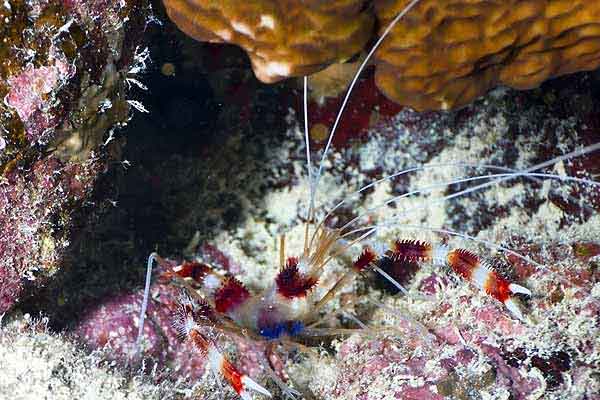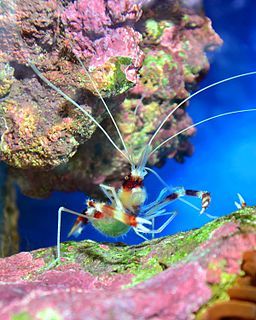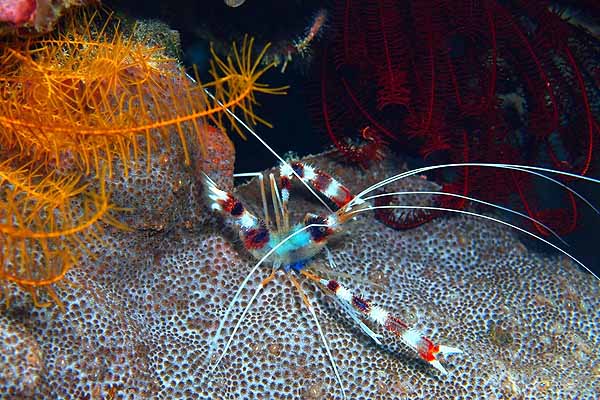[ad_1]
Introduction to the Coral Banded Shrimp
The Stenopus hispidus, commonly known as Boxer Shrimp, Banded Cleaner Shrimp, or Coral Banded Shrimp, is a popular and inexpensive invertebrate to add to your tank. Like some of the other common saltwater aquarium shrimp, you may find that this little fella will be shy and stay hidden among the rocks. If you do have a shy one, you may be able to coax it out at feeding time.
Coral Banded Shrimp have an attractive and unique coloration consisting of alternating red/brown and white bands around its legs and body and have very long front claws. While some of the other popular aquarium cleaner shrimp, like the Scarlet Skunk cleaner shrimp and Blood red Fire shrimp, have a smooth shell, part of what makes the coral banded shrimp unique is the spiny look of its shell.
Their sometimes commonly used name, boxer shrimp, is because of the large pinchers it holds out as protection seemingly in a boxer’s defensive posture.
These creatures usually grow up to about 2-3 inches and have an expected typical lifespan of several years (about 2-3 years in a home aquarium), although there are some (like Saltwater Aquarium Blog reader K D) who shared their personal experience of caring for one in a 30-gallon aquarium for more than 9 years!
Ideal habitat for the coral banded shrimp
In the wild, boxers dwell in rocky areas in the reefs located in the Western Atlantic and Indo – Pacific areas.
Boxer Shrimps are scavengers and will search for food on the tank bottom and rock crevices. They also like to hide especially during daytime and would come out mostly at mealtime, so provide them with plenty of rocks and hiding places to make them feel more secure.
Feeding
The Coral Banded Shrimp is easy to feed because it is a scavenger that will accept a wide range of foods. They are a natural predator of bristle worms, so many aquarium owners will purchase them to help keep that population in check, naturally.
If you find that extra food doesn’t make its way to the bottom of the tank frequently, or that the coral banded shrimp in your saltwater aquarium is particularly aggressive at feeding time, you may want to target feed them using a tool like Julian’s thing to get some food down to a rock crevice where the shrimp can eat in peace without all the chaos and commotion of your more bold aquarium inhabitants.
Behavior and tank mates
Boxer Shrimps are usually peaceful creatures when it comes to cohabitating with fish and coral species, but it is best to avoid keeping these shrimps (unless purchased as a mated pair) singly, since you may see intra-species aggression. You also want to avoid keeping the coral banded shrimp with notorious shrimp eaters like Lionfish, Triggers, or Hawkfish. Absolute advice, like this, is always imprecise because individual fish and invertebrates sometimes act in unique ways or unpredictable ways, but you are likely tempting fate when mixing predator and prey in the same tank.
Breeding Stenopus hispidus
Breeding aquarium shrimp and successfully raising the offspring through metamorphosis is a challenging affair and beyond the scope of this introductory article.
If you are serious about breeding these awesome creatures, I recommend you check out these two sites:
Marine Breeder Initiative
MOFIB
You would likely also find How to Raise & Train Your Peppermint Shrimp, an interesting book–while the rearing techniques would not be identical, you would likely find many similarities.
If you are interested in reading a more scholarly journal article about the reproductive cycle, check out this article.
Conclusions
The Coral Banded Shrimp is a good scavenger and an interesting invertebrate to add to your tank. As long as you keep to the one per tank rule, you should end up with a happy shrimp.
For more information
Want to learn more about the boxer shrimp? Check out this short video:
If you want to learn more about other members of the reef clean up crew, you might be interested in these other articles:
Emerald Crab
Nassarius Snails
Peppermint shrimp care guide
Do you have a Coral Banded Shrimp? Let us know what you think.
[ad_2]
Source link





